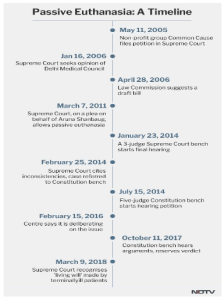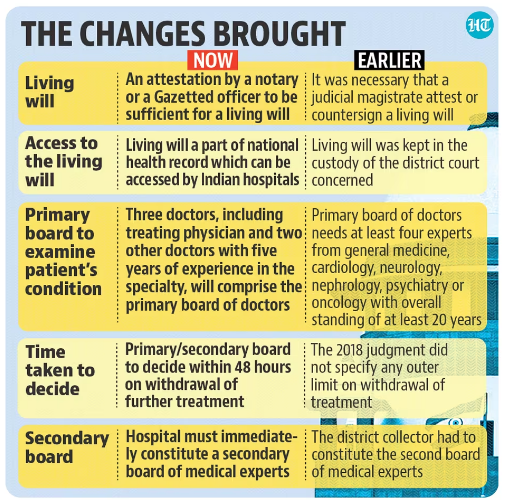Context:
Recently, a 62-years-old woman approached senior administrative officials seeking permission for euthanasia on failing to remove illegal possession from her property.
About Euthanasia:

- Etymology: The word ‘euthanasia’ is a product of two Greek words ‘eu’ meaning ‘good’ and ‘thanatos’ meaning ‘death’.
- Euthanasia refers to the practice under which an individual intentionally ends their life to get relief from an incurable condition, or intolerable suffering.
- Euthanasia falls under the category of assisted dying, which also includes assisted suicide.
- Euthanasia is when an individual ends another person’s life painlessly whereas under assisted suicide a physician assists a patient in ending their life usually by lethal injection.
Types of Euthanasia:
- Active euthanasia: It involves an active intervention to end a person’s life with substances or external force, such as administering a lethal injection.
- Passive euthanasia: It refers to withdrawing life support or treatment that is essential to keep a terminally ill person alive.
- Voluntary euthanasia: It takes place with the consent of the patient.
- Involuntary euthanasia: It is administered without the patient’s consent.
Indian Judiciary on Euthanasia:
- Aruna Ramchandra Shanbaug v. Union of India (2011): In this case, the Supreme Court had held that passive euthanasia can be allowed under exceptional circumstances.
- Common Cause vs. Union of India (2018): The Supreme Court allowed passive euthanasia while recognising the living wills of terminally-ill patients who could go into a permanent vegetative state, and issued guidelines regulating this procedure.
- Living Will: A living will is a legal document that specifies the type of medical care that an individual does or does not want in the event they are unable to communicate their wishes.
- It is also known as an advance directive.
- In 2023 the Supreme Court modified the guidelines to make the right to die with dignity more accessible.

Image Credits: Hindustan Times
Customary Religious Practices:
- Prayopavesa (literally resolving to die through fasting) is a practice in Hinduism that denotes the suicide by fasting of a person who has no desire or ambition left, and no responsibilities remaining in life.
- A similar practice exists in Jainism, termed Santhara.
- In Tamil culture, it is called Vatakkiruttal and Sokushinbutsu in Buddhism.
Global Trends:
- Netherlands, Luxembourg, Belgium: These Countries allow both euthanasia and assisted suicide for anyone who faces “unbearable suffering” that has no chance of improvement.
- Switzerland: Switzerland has banned euthanasia but allows assisted dying in the presence of a doctor or physician.
- Canada: Canada had announced that euthanasia and assisted dying would be allowed for mentally ill patients by March 2023; however, the decision has been widely criticized, and the move may be delayed.
- United States: USA has different laws in different states. Euthanasia is allowed in some states like Washington, Oregon, and Montana.
- United Kingdom: The United Kingdom considers it illegal and equivalent to manslaughter.
| Arguments for Euthanasia |
Arguments against Euthanasia |
- Autonomy and Personal Choice: Euthanasia allows individuals who are suffering from a terminal illness or unbearable pain to have control over their own lives and deaths.
- Alleviating suffering: It provides a compassionate option for individuals who are experiencing immense physical or emotional pain that cannot be effectively managed. It offers a means to end their suffering in a humane and dignified way, preventing prolonged agony.
- Quality of life: It can provide an alternative for individuals who feel that their quality of life has deteriorated to an unbearable extent.
- Resource allocation: It can potentially reduce the financial burden on families and healthcare systems.
|
- Sanctity of life: Many religions and ethical systems consider life to be sacred and believe that intentionally ending one’s own life or aiding in another’s death is morally wrong.
- Slippery slope: Concerns are raised that vulnerable populations, such as those with disabilities or mental illnesses, may be at risk of coercion or abuse if assisted suicide becomes more widely available.
- Medical ethics: The medical profession is based on the principle of “do no harm.” Assisting in suicide can be seen as conflicting with this principle, as it involves intentionally causing or hastening death, which goes against the traditional role of healthcare providers as healers and caregivers.
- Palliative care alternatives: Critics argue that instead of providing the option of euthanasia, more emphasis should be placed on improving palliative care services.
|
Institutional Recommendations:
- The Law Commission of India in its 196th Report recommended that there must be a law made to protect terminally ill patients who refuse medical treatment, artificial nutrition, or hydration from Section 309 of the Indian Penal Code.
Way Forward:
- Public Discourse and Education: Public education campaigns, debates, and forums can help raise awareness, promote understanding, and address concerns related to end-of-life choices.
- Legal Framework: Establishing a comprehensive legal framework is essential which outlines the conditions for accessing euthanasia.
- Safeguards and Protections: Any legislation surrounding euthanasia must include robust safeguards to protect vulnerable individuals.
- Medical Ethics and Professional Guidelines: Collaboration between policymakers, medical professionals, and ethics committees is necessary to develop guidelines and protocols for healthcare practitioners.
- Palliative Care: Enhancing palliative care options can offer alternative choices for those considering euthanasia.
| Additional Information:
Suicide v/s Euthanasia:
- Suicide & euthanasia are conceptually separate. Whether by injuring, intoxication or just about any method, a person committed suicide. Thus, suicide is a deliberate act on the part of the person who commits it.
- Euthanasia, on the other side, involves another individual taking measures to stop the existence of another individual.
Does the Right to Live under article 21 of the Indian Constitution include the Right to Die too?
- P Rathinam Vs Union of India(1994): The judiciary debated whether the punishment for attempting to commit suicide (section 309 of IPC) was right or wrong.
- In this case, the SC upheld that the liberty to die comes under the liberty to live. Thus, section 309 of the IPC was observed to be constitutionally invalid.
- Gian Kaur Vs State of Punjab (1996): The Supreme Court (SC) stated that the right to life enshrined in the Constitution does not mandate the right to die because suicide or someone choosing to die is an unnatural way of putting an end to one’s life.
- SC brought the validity of section 309 back and made an attempt to suicide an offence again.
|
News Source: TOI
To get PDF version, Please click on "Print PDF" button.


